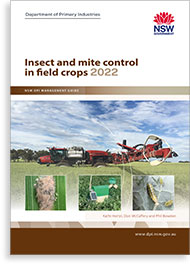
Insect and mite control in field crops

Summary
This updated guide contains information on how to control the more important insect and mite pests of azuki bean, canola, chickpea, cowpea, faba bean, field pea, lentil, linseed, lupin, maize, mungbean, pigeon pea, safflower, sorghum, soybean, sunflower and winter cereal crops, as well as lucerne pasture.
Brief descriptions of some major pests and their damage are given to help you recognise them. There are many links in the guide to more detailed information and for images of common pest species.
A new addition to the guide is information on Fall armyworm, a serious pest in many countries, which arrived in northern Australia in late 2020, and has now become endemic. Fall armyworm is resistant to many common insecticides and is the subject of ongoing research.
Included also is a section on changing farming systems, mainly stubble retention, and what that means in terms of creating more favourable habitats for minor pests to become a more significant pest in some regions and in some seasons.
Most insects are not pests and there are many beneficials often present in crops that help keep a range of pests under control as well as performing other ecosystem services such as pollination and nutrient cycling. These are often destroyed by use of broad spectrum chemicals.
Integrated Pest Management (IPM) remains the long-term goal that uses sound environmental principles to achieve economic control of pests and a reduction of chemical use at the same time. These systems are based on having a dynamic agroecosystem.

